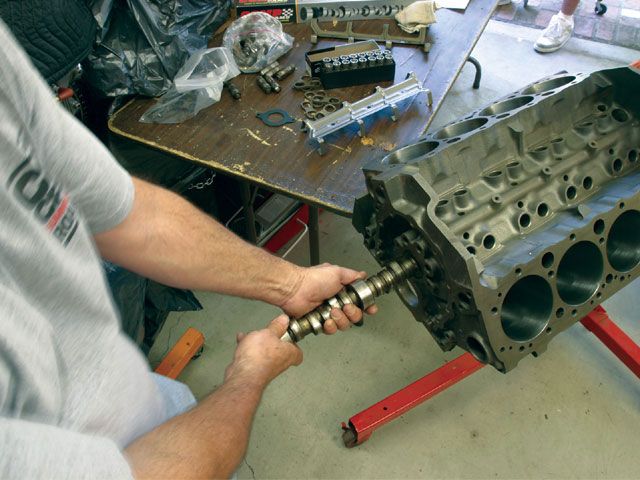
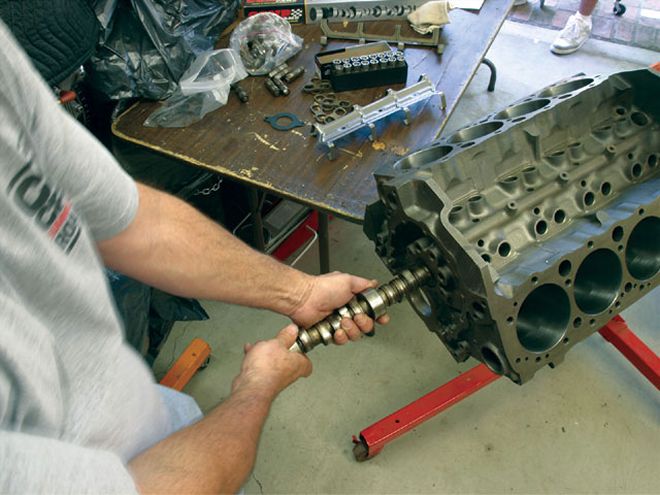 There is a world full of factory hydraulic roller lifter engines in service today ripe for the picking to combine with a good aftermarket hydraulic roller cam.
There is a world full of factory hydraulic roller lifter engines in service today ripe for the picking to combine with a good aftermarket hydraulic roller cam.
The trick to building a budget street engine is to use as many production-based parts as possible. Original-equipment (OE) parts are generally well engineered, durable, and in some cases less expensive than aftermarket hot rod parts. This is especially true when it comes to hydraulic roller cams. General Motors and Ford both switched from flat-tappet hydraulic camshafts to hydraulic roller cams in the mid-'80s. While many car crafters initially scoffed at these conservative grinds, the knowledgeable parts swapper can use those now-plentiful and affordable blocks and roller valvetrains to economic benefit. We're going to tell you how to best combine OE hydraulic roller parts with a stout aftermarket cam-for very little cash. We'll look at both the small-block Chevy and the 5.0L Ford, as they are the most common.
The key to a successful hydraulic roller cam conversion is knowing what parts to use and which ones to avoid. If you've been reading the car magazines for a few years, then you've no doubt heard that you should not reuse old flat-tappet lifters and especially not with a new cam. But happily, there's no such restriction when it comes to hydraulic roller components. Because roller lifters don't slide and generate a wear pattern, you can reuse those factory lifters on a brand-new cam and no one will accuse you of being a roller bonehead. This means that the yards are full of serviceable hydraulic roller lifters that can be obtained for pennies, leaving you more money to spend on camshafts, pushrods, and maybe a set of roller rockers. While it's true that aftermarket hydraulic roller cams are more expensive than their flat-tappet cousins, by not having to purchase the lifters the overall price may actually be less expensive. So follow along as we point the way toward budget-building a hydraulic roller cam valvetrain using common sense instead of cubic dollars.
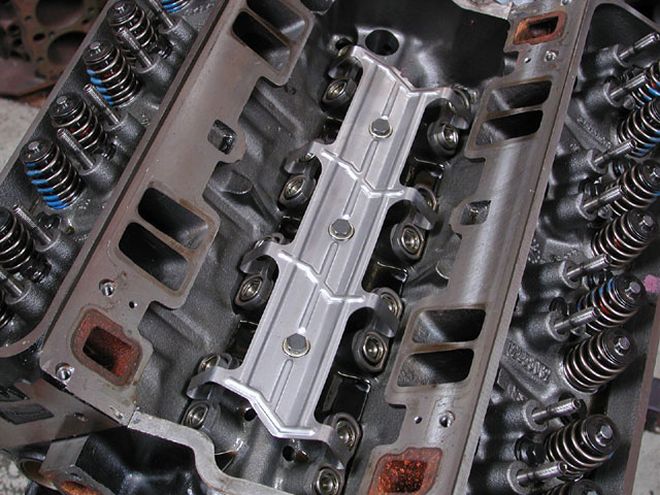 This is the factory hydraulic roller lifter arrangement for an '87-and-newer one-piece rear main seal small-block Chevy. The steel tie-bars keep the lifters aligned in the lifter bores, while the tin spider maintains pressure on the tie-bars to keep them in place.
This is the factory hydraulic roller lifter arrangement for an '87-and-newer one-piece rear main seal small-block Chevy. The steel tie-bars keep the lifters aligned in the lifter bores, while the tin spider maintains pressure on the tie-bars to keep them in place.
Where the Chevy Rollers Are
The original small-block Chevy remained basically unchanged from 1955 through 1985. But in 1986 Chevy finally addressed that leaky two-piece rear main seal by making it one piece, and later added hydraulic roller cams to the 305- and 350ci passenger-car engines that retained the same 0.842-inch lifter diameter. The factory conversion to hydraulic roller cam added slightly taller lifter bosses and three small cast-in perches that mount a stamped-steel spider, along with a two-bolt cam retainer plate located at the nose of the camshaft to limit fore-aft movement in the block. While all passenger-car small-blocks from 1987 on were roller-cammed, light-duty trucks used this same iron block but stuck with a flat-tappet camshaft. This means the block comes with the casting provisions for adapting a factory hydraulic roller camshaft. At the most, you may have to drill and tap a couple of holes. We've even seen four-bolt main hydraulic roller cam blocks.
The hydraulic roller-cammed motors also come with a stepped drive face on the cam, which requires a different cam sprocket with a smaller bolt circle. This is the basic difference between a factory-style hydraulic roller cam and the standard early small-block Chevy flat-cam mount. So the idea is to use a later-model, one-piece rear main seal block with the factory hydraulic roller cam configuration. That way you can reuse the factory hydraulic roller lifters and tie-bar arrangement along with the factory-style cam timing gear. It keeps the price down to almost nothing and frees up more money to spend on a good aftermarket hydraulic roller camshaft. This is an especially good idea when stepping up to a budget cast 383-style crank, rod, and piston package.
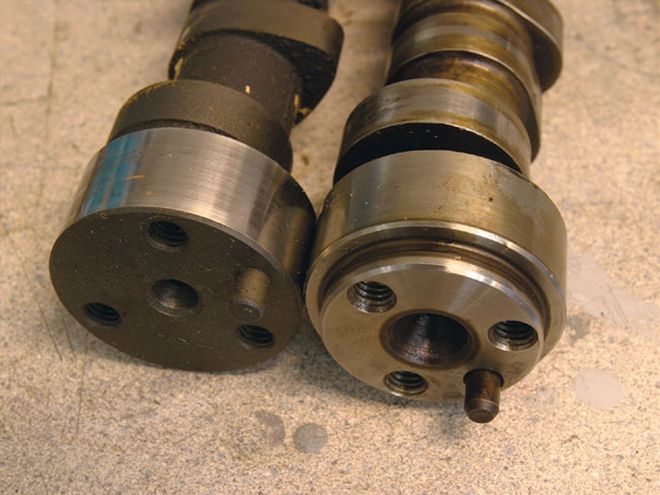 This is a comparison of the standard-style small-block cam nose (left) versus the '87-and-later factory hydraulic roller cam arrangement (right). Note that the factory hydraulic roller uses a step. This stepped nose with a smaller bolt circle must match the cam gear. That means there are two different cam gears for the small-block Chevy depending upon the cam chosen.
This is a comparison of the standard-style small-block cam nose (left) versus the '87-and-later factory hydraulic roller cam arrangement (right). Note that the factory hydraulic roller uses a step. This stepped nose with a smaller bolt circle must match the cam gear. That means there are two different cam gears for the small-block Chevy depending upon the cam chosen.
Roller Warning
One area where you must be careful with production-based small-block Chevy hydraulic roller lifters is with high-lift camshafts. According to Crane's Director of Valvetrain Research and Development, Mark Campbell, valve lifts of more than 0.530 inch at the valve with a 1.5:1 rocker can allow the lifter to fall deep enough into the lifter bore (because of the lobe's small base circle) that the steel retainer can lose its grip on the lifter body. This allows the lifter to spin in the bore and destroy the camshaft. In checking a few cam catalogs, it is possible to order a hydraulic roller camshaft with enough lobe lift (in excess of 0.354 inch) to create this situation, so just be careful. This is why Crane created a long-travel hydraulic roller lifter that will allow you to run a high-lift hydraulic roller cam with the stock lifter configuration. These eliminate the problem but are also much more expensive than OE replacement lifters. Another solution would be to run a 1.6:1 rocker ratio with a reduced lobe lift cam to accomplish more valve lift.
Roller-Cammed Ford 5.0s
Ford has been building 5.0L small-blocks with roller cams since 1984 in fullsize cars (although many others are still flat-tappet motors, so you have to be careful). In the Mustang, the first roller cams appeared in 1985 Mustang and continued through the '95 pushrod motors. One advantage of an '85-'92 Mustang engine is that the pistons are forged, making these an excellent performance engine platform. These engines also make great baselines for a stroker 331- or 347ci small-block, which can be built using the stock hydraulic roller lifter configuration to keep the price down. As you can see from the accompanying Ford parts list, Ford's price on a brand-new set of hydraulic roller lifters is a very affordable $125 compared to as much as $480 for aftermarket lifters.
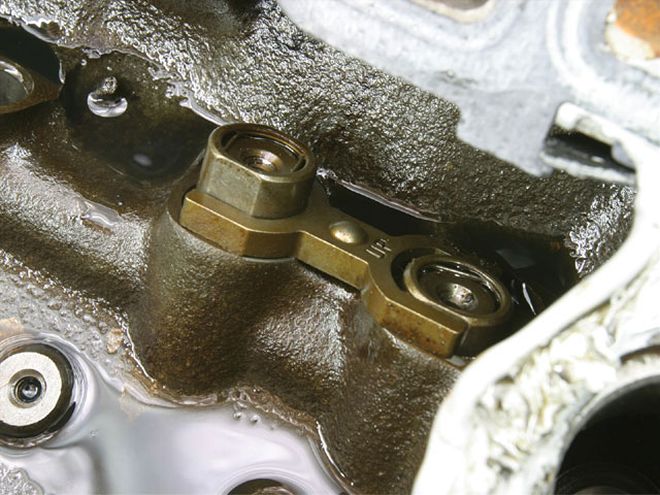 The stock hydraulic roller cams used in Ford 5.0L engines retain the lifters in a similar fashion to the small-block Chevy, with steel retainers that slip over flats on the hydraulic roller lifter. The retainers are held in place with a stamped-steel spider bolted to the cylinder block's lifter valley.
The stock hydraulic roller cams used in Ford 5.0L engines retain the lifters in a similar fashion to the small-block Chevy, with steel retainers that slip over flats on the hydraulic roller lifter. The retainers are held in place with a stamped-steel spider bolted to the cylinder block's lifter valley.
Let's play out a low-budget 5.0L engine scenario here. Yank an '88 5.0L motor out of a boneyard Mustang GT and discard the EFI manifold. We'll assume the engine is in good shape. Do a simple ring-and-bearing rebuild on the short-block and the forged pistons to make sure the engine is well sealed up. Add a gasket set (make sure and get the one-piece oil pan gasket) and a new oil pump, and the short-block is ready. Next, dial in a performance hydraulic roller cam. A good choice would be something around 224 degrees at 0.050-inch tappet lift with around 0.540-inch lift, and plan on reusing the stock hydraulic roller lifters and factory retaining assembly. Then tune up the heads with a valve job, screw-in studs, guideplates, and a good set of rocker arms and valvesprings; top it all off with a set of headers and a dual-plane intake manifold; and you've got a solid 5.0L that will make around 325 hp and 350 lb-ft of torque. If you find a used intake and budget headers, it's entirely possible to build this entire engine for under $1,500.
It's also possible to upgrade the '95-and-later 351W engine with factory-style hydraulic roller lifters and retainer assembly. These engines have the bosses cast into the block, which makes the conversion much easier. Comp Cams sells a retrofit roller lifter kit (PN 31-1000 and 31-1001) with a stock-type spider and retainers that can be added to certain of these blocks. However, this will require the proper base circle hydraulic roller cam to ensure that the roller lifters don't travel beyond the vertical capacity of the lifter bores.
CHEVY PARTS LIST DESCRIPTION PN SOURCE PRICE GMPP hyd. roller lifter kit 12371042 Scoggin-Dickey $214.95 GM guide for roller lifters, ea. 12550002 Scoggin-Dickey 3.84 GM spider retainer plate 14101116 Scoggin-Dickey 13.34 GMPP pushrod, hyd. roller 10046173 Scoggin-Dickey 169.44 GMPP Hot roller cam 24502586 Scoggin-Dickey 192.95 GMPP 350 Hot cam kit 12480002 Scoggin-Dickey 536.95 GM early cam retainer plate 10088128 Scoggin-Dickey 10.22 GM late cam retainer plate 10168501 Scoggin-Dickey 10.07 GM countersunk bolts, ea. 14093637 Scoggin-Dickey 0.86 GM melonized dist. gear 10456413 Scoggin-Dickey 32.95 Comp OE roller install kit 08-1000 {{{Summit}}} Racing {{{100}}}.69 Comp OE-style hyd. rollers {{{850}}}-16 Summit Racing 245.95 Comp retrofit hyd. rollers 885-16 Summit Racing 509.95 Comp hyd. roller timing set 2136 Summit Racing 92.95 Comp hyd. roller camshaft 08-423-8 Summit Racing 255.95 Crane OE-style hyd. rollers 10530-16 Summit Racing 205.95 Crane retrofit hyd. rollers 11515-16 Summit Racing 299.95 Crane long-travel hyd. rollers 10535-16 Summit Racing 529.95 Crane hyd. roller timing set 10993-1 Summit Racing 71.39 Crane coated dist. gear 11951-1 Summit Racing 61.99 Crane coated dist. gear 11950-1 Summit Racing 61.99 Crane hyd. roller cam 109831 Summit Racing 295.95 Crane retrofit roller cam 119821 Summit Racing 309.95 FORD PARTS LIST DESCRIPTION PN SOURCE PRICE {{{Ford}}} Racing hyd. roller cam {{{M}}}-6250-E303 {{{Summit}}} Racing $174.95 Ford Racing hyd. roller cam M-6250-B303 Summit Racing 174.95 Ford OE 16 roller lifters M-6500-R302 Summit Racing 122.95 Ford Racing retrofit lifters M-6500-S58 Summit Racing 469.95 Ford steel cam thrust plate M-6269-A351 Summit Racing 41.88 Ford steel distributor gear M-12390-B Summit Racing 39.88 Comp roller lifter install kit 35-1001 Summit Racing 50.99 Comp retrofit roller kit 35-1000 Summit Racing 51.39 Comp OE 16 roller lifters 851-16 Summit Racing 245.95 Comp retrofit hyd. roller kit 31-1000 Summit Racing 51.39 Comp hyd. roller cam 35-518-8 Summit Racing 255.95 Crane OE 16 roller lifters 36530-16 Summit Racing 179.95 Crane retrofit hyd. rollers 36532-16 Summit Racing 479.95 Crane coated dist. gear 36970-1 Summit Racing 65.95 Crane 31/48-in rocker studs 99157-16 Summit Racing 46.88 Crane guideplates 36650-1 Summit Racing 27.88 Crane pushrods, 0.080-wall 36623-16 Summit Racing 81.88 Crane Energizer rocker, 1.6 11746-16 Summit Racing 199.95 Crane hyd. roller cam 444221 Summit Racing 185.95 Crane retrofit roller cam 444215 Summit Racing 239.95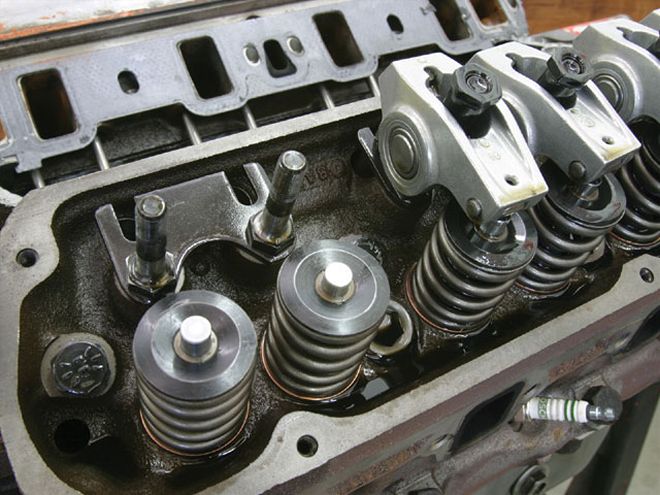 All Ford hydraulic roller cam motors use a net valve lash system for the rocker arms. When moving up to a performance roller cam, you should spend the money to have the stock heads machined for screw-in studs and guideplates so you can use an adjustable valvetrain and roller rockers. These stock iron heads now sport Crane 31/48-inch screw-in studs, guideplates, hardened pushrods, and Energizer 1.6:1 roller rockers. Slover's Porting Service did the work for us on these heads.
All Ford hydraulic roller cam motors use a net valve lash system for the rocker arms. When moving up to a performance roller cam, you should spend the money to have the stock heads machined for screw-in studs and guideplates so you can use an adjustable valvetrain and roller rockers. These stock iron heads now sport Crane 31/48-inch screw-in studs, guideplates, hardened pushrods, and Energizer 1.6:1 roller rockers. Slover's Porting Service did the work for us on these heads.
Ford Firing Order
If you are considering swapping in a hydraulic roller cam into an earlier block, be sure to pay attention to the firing order. Early small-block 289/302 Fords used the 1-5-4-2-6-3-7-8 firing order. But when Ford converted to the 5.0L roller cam engines, it changed the firing order to the 351W sequence 1-3-7-2-6-5-4-8. Just to make it really confusing, the same-era fullsize Fords without roller cams retain the older 289/302 firing order. When purchasing an aftermarket hydraulic roller camshaft, be sure you know which firing order the cam is ground with. Most aftermarket hydraulic roller cams are produced with the 5.0L/351W firing order. Also worth noting is that Ford numbers its cylinders 1 through 4 front to rear on the passenger side with 5 through 8 on the driver side.
What is a RetroFit?
Because both the small-block Ford and small-block Chevy engines came in both flat-tappet and hydraulic roller versions, this does cause some confusion for parts buyers. To convert an early flat-tappet engine to a roller cam requires what the cam companies call a retrofit kit. These early engines cannot utilize the factory-style hydraulic roller lifters and retainer design. Unfortunately, this means that the cam packages and especially the lifters are more expensive. So if there is a 355 or 383 small-block Chevy or a 5.0L Ford in your future, you should consider going with a factory-style hydraulic roller cam and lifter setup. OE-style replacement hydraulic roller lifters are much less expensive, and as long as you're not spinning over 6,500 rpm, this would be a great combination as opposed to the more expensive retrofit roller cam kits.